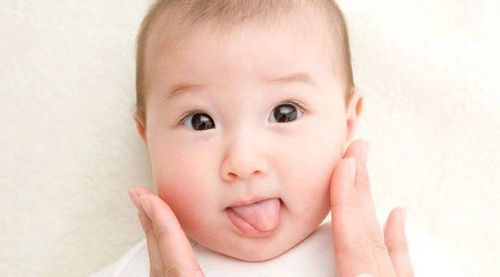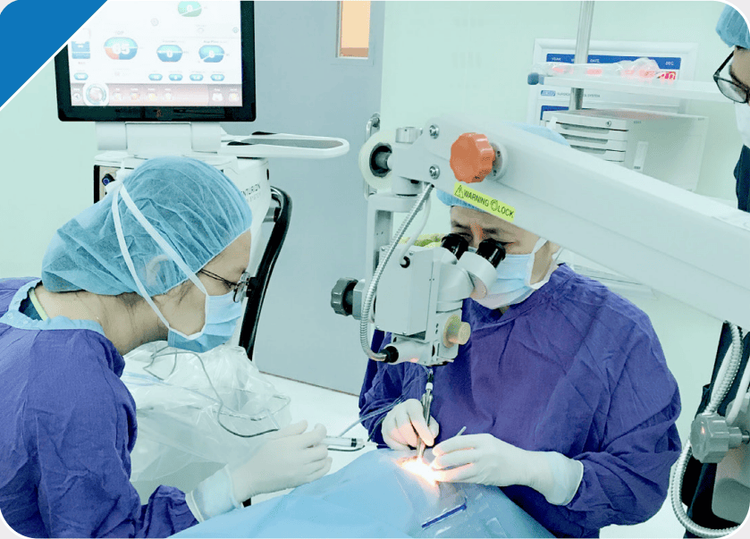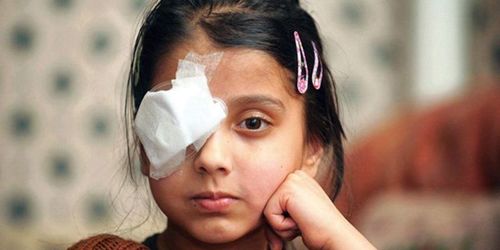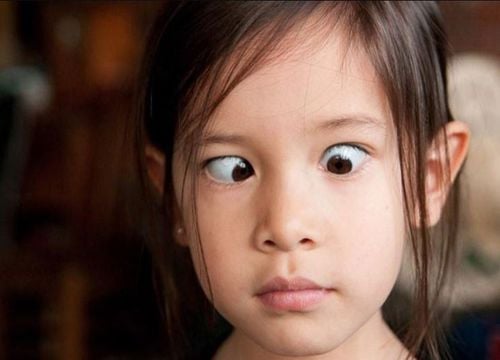This is an automatically translated article.
Every child can have vision problems and, if left untreated, can lead to blindness. Early detection and timely treatment help children to almost completely return to normal vision, helping children learn and develop at their best. So how to recognize children's vision problems early.1. Signs of a child's vision problem
A young child's eyes take a while to adjust to the world around them, so they may not always look or function the way you expect at first. For example, during the first three months of a newborn's life, it's perfectly normal for a baby to have a cross-eyed or not being able to look at your face for long.However, in the early stages of a child's life there can still be problems with vision. Talk to your child's doctor if you notice any of the following:
Your baby's eyes are not moving normally. For example, one side moves and the other doesn't, or one side moves out of sync with the other eye (moves in a different direction). If your baby is more than 1 month old, but lights, cell phones and other attention-grabbing objects still won't get your baby's attention. One of your baby's eyes never opens. Your baby has a persistent, unusual spot in the eye when flash photography is taken. For example, instead of the common red-eye caused by camera flash, there is a white spot. You notice white, grayish-white, or yellow matter in the pupils of your baby's eyes. (The baby's eyes look cloudy.) One (or both) of the baby's eyes are bulging. One or both of your baby's eyelids appear to be drooping. Babies often squint. Babies often rub their eyes when they are not sleepy. Your baby's eyes appear to be sensitive to light. One of your baby's eyes is larger than the other, or the pupils are different sizes. You notice any other changes in your child's eyes from the way he usually looks. Also, when your baby is 3 months old, talk to your doctor if you notice any of the following:
Your baby's eyes turn inward or outward and stay that way. Your baby's eyes won't follow the toy being moved from side to side in front of him. Your baby's eyes seem to jump back and forth or wiggle. Babies always seem to tilt their heads when looking at things. You should also check with your child's eye doctor if he or she has any signs of a blocked tear duct or infection, such as pink eye. These signs include heavy watering, redness that lasts more than a few days, or pus or scabs in the eye.

Bạn cũng nên đưa trẻ đi kiểm tra với bác sĩ mắt của trẻ nếu trẻ có bất kỳ dấu hiệu nào của ống lệ bị tắc hoặc nhiễm trùng, chẳng hạn như đau mắt đỏ
2. Common causes of children's eye problems
Eye disorders that can affect your child's vision can be divided into two groups:Pathologies related to refractive errors: eye disorders in which unfocused light enters the eye as normal, leading to blurred vision. Group of diseases not caused by refractive error: eye disorders due to eye diseases. 2.1. What are refractive errors? Refractive errors occur in nearly 20% of children. The most common refractive errors, all of which affect vision, are:
Myopia or nearsightedness: Myopia is the most common refractive error in children. Myopia means that a child can see up close but has problems seeing things that are far away. Farsightedness is a type of refractive error in which a child cannot see things that are close to him, but he has no problem seeing things that are far away. This is not usually common in children. Most children usually have a mild degree of farsightedness until they are 7 years old. Astigmatism is a condition in which the cornea is abnormally curved, leading to decreased vision. This can start in childhood or adulthood and can be easily corrected if it causes problems. Some of the signs and symptoms of astigmatism may include headache, eye strain, difficulty reading, and fatigue. Amblyopia is characterized by a reduction in vision that occurs in one eye, usually due to another problem in which that eye is not receiving proper visual stimulation. This is usually preventable if the underlying cause is treated before the child is 6 years old. Strabismus or crossed eyes is one of the common eye defects in children in which the eye is misaligned. One or both eyes may turn inward (oblique eye), outward (wall eye), up or down. Sometimes, a child may have more than one of these conditions. Children under 6 months of age can have a common form of strabismus that will go away on its own. This type of strabismus may be normal. Strabismus can be caused by poor eye muscles, while some babies are born simply with crossed eyes.

Trẻ em dưới 6 tháng tuổi có thể mắc một dạng lác thông thường và sẽ tự biến mất sau đó
Child squints; The child cannot properly assess the distance to pick up objects; The child closes one eye to see better; Children often get dizzy; Children whose eyes move inward or outward. Early diagnosis of underlying eye problems is necessary to prevent vision loss. Treatment for crossed eyes may include patching the stronger eye to strengthen the weaker eye, wearing glasses, straightening surgery, or doing eye exercises.
2.2. What are non-refractive errors? 2.2.1. Glaucoma Glaucoma is a condition in which the fluid pressure inside the eye (intraocular pressure or IOP) slowly rises because the aqueous humor - which normally flows in and out of the eye - cannot drain properly. Instead, fluid builds up and causes pressure damage to the optic nerve (a bundle of more than 1 million nerve fibers that connects the retina to the brain) and vision loss.
Glaucoma is classified by age of onset. Glaucoma that begins before a child is 3 years old is called neonatal or congenital (present at birth) glaucoma. Glaucoma that occurs in children is called childhood glaucoma.
2.2.2. Cataracts A cataract is a covered or opaque area on the lens of the eye that is normally transparent. When this happens, it prevents light rays from passing through the lens and focusing on the retina, the light-sensitive epithelial lining at the back of the eye. This clumping occurs when some of the proteins that make up the lens begin to clump together and interfere with vision.
Cataracts can affect one eye (one eye) or both eyes (bilateral). Cataracts in children are uncommon. A child can be born with the disease (congenital), or it can develop it later in life (acquired). Possible causes of cataracts include:
Trauma; Diabetes; Poisoned; Steroid use; Other congenital diseases, such as rheumatoid arthritis; Complications from other eye conditions, such as glaucoma. Most cases of congenital (present at birth) cataracts appear in children who also have other eye diseases or other health problems. About 25% of children are born with congenital cataracts, which are caused by a genetic predisposition, such as a metabolic disorder (due to an inherited enzyme deficiency) or a chromosomal abnormality (i.e., chromosomal syndrome). Down syndrome).
Signs and symptoms of cataracts may include:
Blurred vision or a feeling that clouds are covering your vision; Decreased vision; Feeling like there are bright lights in the eyes and/or glare or halos around; The pupil is white when looking at the flashlight; Double look; Colors appear faded; Increasing myopia, increasing the need to change prescription glasses. Cataract treatment usually includes surgery.

Điều trị đục thủy tinh thể thường bao gồm phẫu thuật
Approximately 250 children in the United States are diagnosed with this type of cancer each year. It mainly occurs in children under 5 years of age. The highest incidence occurs between birth and 2 years of age. Both men and women are equally affected. Retinoblastoma can occur in both eyes, but in about 25 to 30% of cases, the tumor is present in both eyes.
Signs and symptoms of retinoblastoma may include:
Leukocoria: a white light reflex that occurs at certain angles when light hits the pupil; Strabismus (also called "wandering eyes" or "crossed eyes"): a misalignment of the eyes in which one or both eyes do not seem to "see" in the same direction; Pain or redness around the eyes; Poor vision or changes in the child's vision. Treatment for retinoblastoma may include one or more of the following:
Surgical removal of part or all of the eye or eye involved in the tumor; Chemotherapy; Radiotherapy; Phototherapy (using light to destroy blood vessels supplying the tumor); Cryotherapy (using freezing to destroy the tumor); Exercise adaptive physical therapy for blindness or vision loss; Supportive care (for treatment side effects); Antibiotics (to prevent/treat infections).

Bác sĩ có thể kê cho trẻ kháng sinh để ngăn ngừa hoặc điều trị nhiễm trùng
Children's general health examination, optometry with leading eye specialists in the country. Package of screening for refractive errors (strabismus, nearsightedness, farsightedness, astigmatism, amblyopia) through general and conventional eye exams. Monitor and manage periodically for 1 year for patients with refractive errors. Glocom package performs comprehensive examination and surgery (if any) for customers with Glaucoma symptoms. Cataract surgery consultation and examination package If you need to examine, consult and treat vision problems for children, please book an appointment directly at the website or contact the hotline for advice. detailed problem.
Please dial HOTLINE for more information or register for an appointment HERE. Download MyVinmec app to make appointments faster and to manage your bookings easily.
Reference source: babycenter.com












